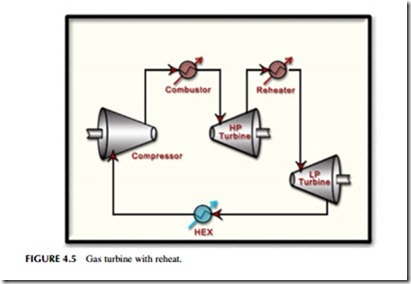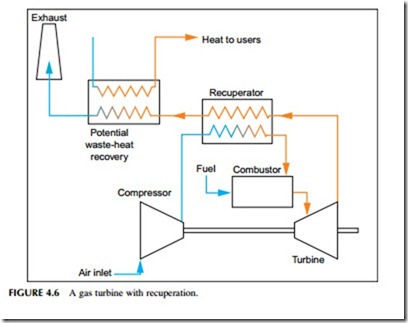ADVANCED GAS TURBINE CYCLES
The basic gas turbine configuration as just outlined can be modified in a number of ways to attempt to enhance the performance. Reheating, alluded to briefly already, involves adding a second combustion stage and splitting the turbine section into two parts. Intercooling is an analogous modification to the compressor in which this is divided into two stages, with cooling of the air in between them. Water vapor or steam injection into the inlet air before, within, or after the compressor can increase overall efficiency by creating a larger mass flow for less energy input. Finally, it is possible to capture some of the heat from the exhaust of a simple cycle gas turbine and use it to heat the compressed air from the compressor stage before it enters the combustion chamber, again leading to an improvement in efficiency. Some of these modifications can be utilized in gas turbines within combined cycle configurations, and others are only useful when the gas turbine is operating in an open cycle.
Reheating
In large steam turbine–based power plants it is traditional to split the turbine into separate sections: one handling high-pressure steam, one handling intermediate-pressure steam, and a third handling low-pressure steam. By split- ting the turbine this way, efficiency gains can be made through matching the individual turbine sections to operate under a narrower range of steam pressures. Further, once the turbine has been split into separate sections, additional efficiency gains can be made by reheating the steam when it exits the high- pressure turbine (where it will have cooled) and before it enters the intermediate-pressure turbine. This is a common feature of the steam turbines used in coal-fired power plants.
The power turbine stage of a gas turbine can also be divided up in a similar way, though normally only two separate sections, called spools,7 are used as shown in Figure 4.5. One of these is called the high-pressure spool and the second a low-pressure spool. Once the turbine has been split into spools it is possible to introduce a second combustion stage to reheat the air between the high-pressure and low-pressure spool of the power turbine. Reheating increases turbine efficiency in the same way as for a steam turbine by optimizing power
turbine and gas flow conditions. Further, it can allow the turbine to achieve higher efficiency with a lower turbine inlet temperature, making less demand on material performance.
Reheating is used by at least one major manufacturer8 to achieve high efficiency in large gas turbines. These units also operate at a relatively high compression ratio of 30:1, similar to many aero-derivative gas turbines.
Intercooling
It is possible to go a stage further with a gas turbine by splitting the compressor into two sections: a low-pressure compressor section and a high-pressure compression section. As with the reheating of the air between the two spools of the turbine, it is possible to improve efficiency by cooling the air between the two spools of the compressor. (Compressing air generates heat, which raises the temperature of the air and hot air occupies a larger volume. Cooling it reduces the volume so the compressor actually has less work to do.) This is called intercooling.
Intercooling a high-performance aero-derivative gas turbine can boost its efficiency by around 5%, double its power output, and substantially reduce the cost per kilowatt of generating capacity.
Recuperation
A third strategy for improving the performance of a gas turbine is to use heat from the turbine exhaust to partially heat the compressed air from the compres- sor before it enters the combustion chamber. This process, referred to as recuperation, results in less fuel being needed to raise the air to the required turbine inlet temperature (Figure 4.6). In effect, the recuperated gas turbine cycle is allowing more energy to be captured from the air, increasing overall thermodynamic efficiency.
Recuperation uses heat in the gas turbine exhaust that would be captured in a combined cycle plant so this technique will not normally be applied in that con- figuration. However, it has been used successfully in a number of small gas turbines to provide higher efficiency. It is also a feature of many micro-turbines.
Mass Injection
A final strategy for increasing efficiency of a gas turbine is to inject water or water vapor into the air supplied to the turbine. Injection may take place at the compressor inlet, at stages through the compressor, or at the combustion chamber. In all cases the aim is to increase mass flow through the turbine.
The steam-injected gas turbine (STIG) cycle involves using a heat-recovery steam generator to produce steam from the exhaust gas of the gas turbine in much the same way as in a combined cycle station. This steam is then injected
into the combustion chamber of the turbine. This increases the mass flow into the turbine stages with a consequent increase in overall efficiency. An added advantage is that injection of steam into the combustion chamber can reduce Nitrogen oxide generation. A STIG cycle can increase overall gas turbine efficiency between 2% and 4%.
The humid-air turbine (HAT) cycle is a more complex cycle in which inlet air is intercooled part way through the compressor and at the exit of the compressor and then passed through a humidifier where it becomes almost saturated with water vapor before entering the combustion chamber. Recuperation is then employed to heat the humidified air and gain the highest possible efficiency in use of energy. For small gas turbines, this cycle is potentially more efficient than the equivalent combined cycle configuration.
Other HAT cycles are also possible. The cascaded HAT (CHAT) cycle introduces a reheating stage between the high-pressure spool and the low- pressure spool of the power turbine. Another variant called TOP Humid Air Cycle (TOPHAT) injects water into various stages of the compressor while the advanced HAT (AHAT) cycle injects water at the compressor inlet.
Various claims have been made for the HAT cycle and its variants with efficiencies as high as 55% in a large CHAT system. These suggest that in principle a HAT cycle turbine can approach the efficiency of a combined cycle power plant but without the complexity of a steam turbine and at lower inlet temperatures. However, the cycle cannot complete with the efficiency levels now being achieved in large combined cycle plants. Another disadvantage of HAT and CHAT cycle power units is that they release a considerable amount of water vapor into the environment. In situations where water is scarce it may be necessary to recover the water from the exhaust gas, adding to cost and complexity.
Along with the cycles described here there are a number of other variants of both the STIG and HAT cycles. Most have not been widely adopted commercially.

